Bhushan B. Nanotribology and Nanomechanics: An Introduction
Подождите немного. Документ загружается.

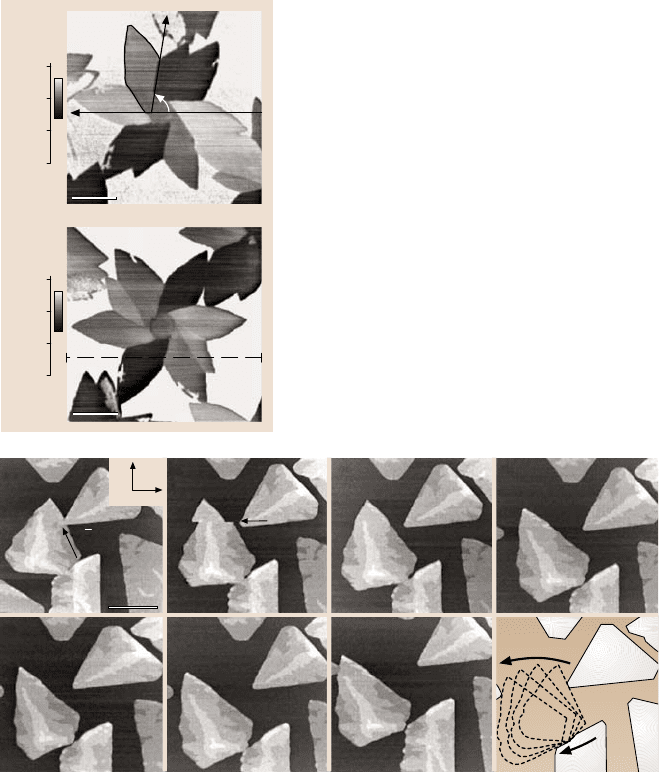
11 Friction and Wear on the Atomic Scale 575
a)
b)
– 0.5
– 0.7
– 0.9
– 1.1
– 0.5
– 0.7
– 0.9
– 1.1
Scan
direction
θ
Fig. 11.21. Friction images of a thiolipid mono-
layer on a mica surface. (After [41])
h)
[110]
I
[100]
[10]
200 nm
a) b) c) d)
e) f) g)
Fig. 11.22. Sequence of topography images of C
60
islands on NaCl(100). (After [42])
(Fig. 11.25). This effect cannot be interpreted within the mechanical approach in
Sect. 11.2 without further assumptions.
11.4.1 The Tomlinson Model at Finite Temperature
Let us focus again on the energy profile discussed in Sect. 11.2.1. For the sake
of simplicity, we will assume that γ 1. At a given time t < t
∗
, the tip jump is
preventedby the energybarrier ΔE = E(x
max
,t)−E(x
min
,t), where x
max
corresponds
to the first maximum observed in the energy profileand x
min
is the actual position of
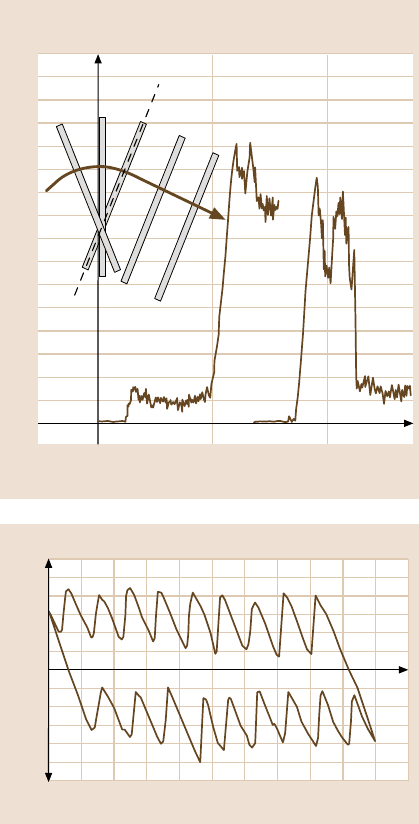
576 Enrico Gnecco et al.
Lateral force
(arb. units)
0.8
0.6
0.4
0.2
0.0
Cantilever support displacement (nm)
200 4000
1
2
3
4
5
5
4
3
2
1
Fig. 11.23. Friction force
experienced as a carbon
nanotube is rotated into (left
trace) and out of (right trace)
commensurate contact. (Af-
ter [43])
F
L
(nN)
0.6
0.4
0.2
0.0
– 0.2
– 0.4
– 0.6
x (nm)
012345
Fig. 11.24. Friction loop on
NaCl(100). (After [48])
the tip (Fig. 11.26). The quantity ΔE decreases with time or, equivalently, with the
frictional force F
L
until it vanishes when F
L
= F
∗
(Fig. 11.27). Close to the critical
point, the energy barrier can be written approximately as
ΔE = λ(
˜
F −F
L
) , (11.17)
where
˜
F is close to the critical value F
∗
= πE
0
/a.
At finite temperature T, the lateral force required to induce a jump is lower
than F
∗
. To estimate the most probable value of F
L
at this point, we first consider
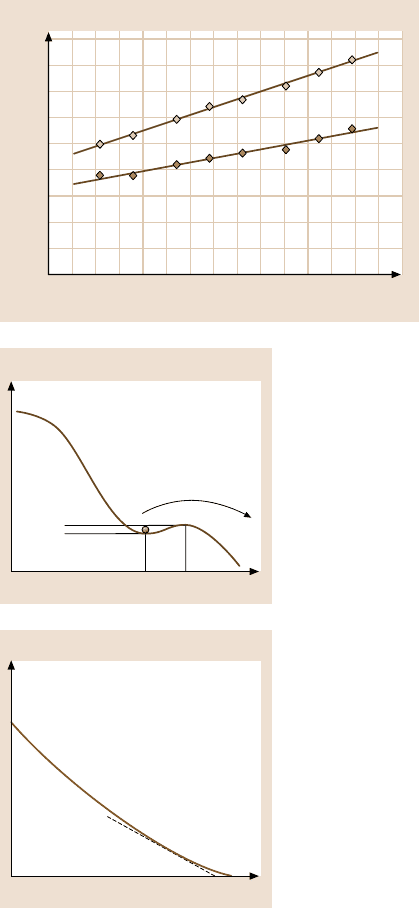
11 Friction and Wear on the Atomic Scale 577
F
L
(nN)
0.4
0.3
0.2
0.1
0.0
In v (nm/s)
12345678
Fig. 11.25. Mean friction
force versus scanning ve-
locity on NaCl(100) at
F
N
= 0.44nN (+)and
F
N
= 0.65nN (×). (After [48])
E (x,t)
x
min
x
max
x
ΔE
Fig. 11.26. Energy barrier that hinders the tip jump
in the Tomlinson model
F
L
ΔE
F
*
Fig. 11.27. Energy barrier ΔE as a function of the
lateral force F
L
.Thedashed line close to the criti-
cal value corresponds to the linear approximation
(11.17)

578 Enrico Gnecco et al.
the probability p that the tip does not jump. The probability p changes with time t
according to the master equation
dp(t)
dt
= −f
0
exp
−
ΔE(t)
k
B
T
p(t) , (11.18)
where f
0
is a characteristic frequency of the system. The physical meaning of this
frequency is discussed in Sect. 11.4.2. We should note that the probability of a re-
verse jump is neglected, since in this case the energy barrier that must be overcome
is much higher than ΔE. If time is replaced by the corresponding lateral force, the
master equation becomes
dp(F
L
)
dF
L
= −f
0
exp
−
ΔE(F
L
)
k
B
T
dF
L
dt
−1
p(F
L
). (11.19)
At this point, we substitute
dF
L
dt
=
dF
L
dX
dX
dt
= k
eff
v (11.20)
and use the approximation (11.17). The maximum probability transition condition
d
2
p(F)/ dF
2
= 0thenyields
F
L
(v) = F
∗
−
k
B
T
λ
ln
v
c
v
(11.21)
with
v
c
=
f
0
k
B
T
k
eff
λ
. (11.22)
Thus, the lateral force depends logarithmically on the sliding velocity, as observed
experimentally. However, approximation (11.17) does not hold when the tip jump
occurs very close to the critical point x = x
∗
, which is the case at high velocities.
In this instance, the factor (dF
L
dt)
−1
in (11.19) is small and, consequently, the
probability p(t) does not change significantly until it suddenly approaches 1 when
t → t
∗
. Thus friction is constant at high velocities, in agreement with the classical
Coulomb’s law of friction [28].
Sang et al. [50] observed that the energy barrier close to the critical point is
better approximated by a relation like
ΔE = μ(F
∗
−F
L
)
3/2
. (11.23)
The same analysis performed using approximation (11.23) instead of (11.17) leads
to the expression [51]
μ(F
∗
−F
L
)
3/2
k
B
T
= ln
v
c
v
−ln
1−
F
∗
F
L
, (11.24)
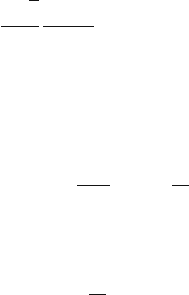
11 Friction and Wear on the Atomic Scale 579
where the critical velocity v
c
is now
v
c
=
π
√
2
2
f
0
k
B
T
k
eff
a
. (11.25)
The velocity v
c
discriminates between two different regimes. If v v
c
,the
second logarithm in (11.24) can be neglected, which leads to the logarithmic
dependence
F
L
(v) = F
∗
−
k
B
T
μ
2/3
ln
v
c
v
2/3
. (11.26)
In the opposite case, v v
c
, the term on the left in (11.23) is negligible and
F
L
(v) = F
∗
1−
v
c
v
2
. (11.27)
In such a case, the lateral force F
L
tends to F
∗
, as expected.
In a recent work, Reimann et al. distinguished between the dissipation that oc-
curs in the tip apex and that in the substrate volume in contact with the tip [52].
After the initial logarithmic increase, the velocity dependence of friction changes
in different ways, depending on the relative contribution of the tip apex to the to-
tal dissipation. A ‘friction plateau’ is only predicted when θ ≈ 0.5 over a limited
velocity range. At lower or higher values of θ, friction is expected to increase, or,
respectively, decrease beyond the critical velocity ν
c
.
The thermally activated Tomlinson model has been recently extended to two
dimensions by Fasolino and coworkers [53].
11.4.2 Velocity Dependence of Friction
The velocity dependence of friction was only recently studied by FFM. Zwörner
et al. observed that friction between silicon tips and diamond, graphite or amor-
phous carbon is constant with scan velocities of a few µm/s [54]. The friction de-
creased when v was reduced below 1µm/s. In their experiment on lipid films on
mica (Sect. 11.3.1), Gourdon et al. [49] explored a range of velocities from 0.01
to 50 µm/s and found a critical velocity v
c
= 3.5 µm/s that discriminates between
an increasing friction and a constant frictionregime (Fig. 11.28). Although these re-
sultswere not explainedby thermalactivation,we arguethat the previoustheoretical
discussion gives the correct interpretative key. A clear observation of a logarithmic
dependence of friction on the micrometer scale was reported by Bouhacina et al.,
who studied friction on triethoxysilane molecules and polymers grafted on silica
with sliding velocities of up to v = 300µm/s [55]. The result was explained with
a thermally activated Eyring model, which does not differ significantly from the
model discussed in the previous subsection [56,57].
The first measurements on the atomic scale were performed by Bennewitz et al.
on copper and sodium chloride [31, 48]; in both cases a logarithmic dependence
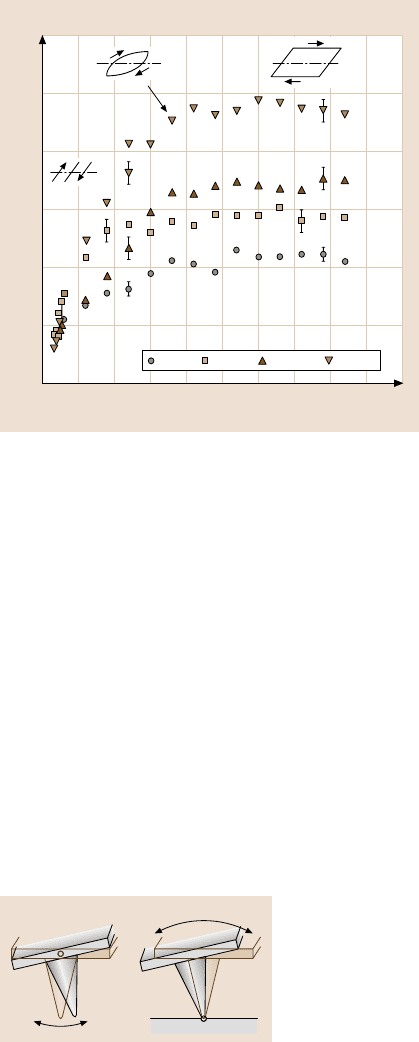
580 Enrico Gnecco et al.
Mica Fluid Arm 4 Arm 5
LFM signal (arb. units)
300
250
200
150
100
50
0
0
Velocity (μm/s)
246810
Fig. 11.28. Velocity depen-
dence of friction on mica and
on lipid films with different
orientations (arms 4 and 5)
andinafluidphase.(Af-
ter [49])
of friction was revealed up to v < 1 µm/s (Fig. 11.25), in agreement with (11.21).
Higher values of velocities were not explored, due to the limited range of the scan
frequencies possible with FFM on the atomic scale. The same limitation does not
allow a clear distinction between (11.21) and (11.26) when interpreting the experi-
mental results.
At this point we would like to discuss the physical meaning of the characteristic
frequency f
0
. With a lattice constant a of a few angstroms and an effective spring
constant k
eff
of about 1N/m, which are typical of FFM experiments, (11.25) gives
a valueof a few hundredkHz for f
0
. This is the characteristic range in which the tor-
sional eigenfrequenciesof the cantilevers are located in both contactand noncontact
modes (Fig. 11.29). Future work may clarify whether or not f
0
must be identified
with these frequencies.
To conclude this section, we should emphasize that the increase in friction with
increasing velocity is ultimately related to the materials and the environment in
which the measurements are realized. In a humid environment, Riedo et al. ob-
served that the surface wettability plays an important role [59]. Friction decreases
a) b)
Fig. 11.29. Torsional modes of cantilever oscilla-
tion (a) when the tip is free and (b) when the tip is
in contact with a surface. (After [58])
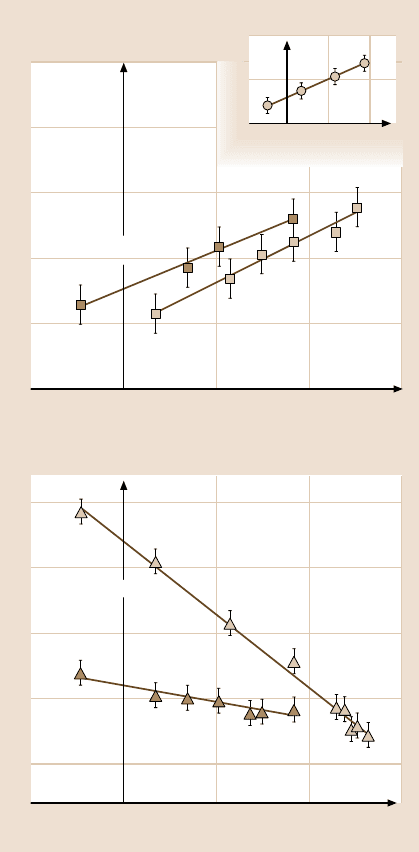
11 Friction and Wear on the Atomic Scale 581
12
11
10
9
8
7
F
F
(nN)
ln[ν(μm/s)]
6420–2
14
12
10
8
6
a)
b)
ln[ν(μm/s)]
6
4
20
–2
F
F
(nN)
DLC
HT-CrN
P/P
s
= 0.34
P/P
s
= 0.65
P/P
s
= 0.34
P/P
s
= 0.01
12
10
8
P/P
s
= 0.65
ln[ν(μm/s)]
F
F
(nN)
024
Fig. 11.30. Friction versus
sliding velocity (a) on hydro-
phobic surfaces and (b)on
hydrophilic surfaces. (After
[59])
with increasing velocity on hydrophilic surfaces, and the rate of this decrease de-
pends drastically on humidity. A logarithmic increase is again found on partially
hydrophobic surfaces (Fig. 11.30). These results were interpreted considering the
thermally activated nucleation of water bridges between tip and sample asperities,
as discussed in the cited reference.
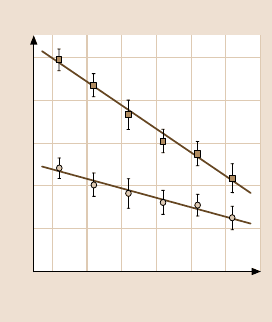
582 Enrico Gnecco et al.
9
6
3
T(K)
330320310300
F
F
(nN)
n–C
16
H
34
OMCTS
Fig. 11.31. Temperature dependence of friction
on n-hexadecane and octamethylcyclotetrasilox-
ane. (After [60])
11.4.3 Temperature Dependence of Friction
Thus far we have used thermal activation to explain the velocity dependence of
friction. The same mechanism also predicts that friction should change with tem-
perature. The master equation (11.18) shows that the probability of a tip jump is
reduced at low temperatures T until it vanishes when T = 0. Within this limit case,
thermal activation is excluded, and the lateral force F
L
is equal to F
∗
, independent
of the scanning velocity v.
To our knowledge, stick-slip processes at low temperatures have not been re-
ported. A significant increase in the mean friction with decreasing temperature was
recentlymeasured by He et al. [60] by FFM (Fig. 11.31). Neglecting logarithmic
contributions, (11.21) and (11.26) predict that (F
∗
−F
L
) ≈ T and (F
∗
−F
L
) ≈ T
2/3
respectively for the temperature dependence of friction. Although He et al. applied
a linear fit to theirdata, the 30 K range thatthey consideredis again not large enough
to prove that a T
2/3
fit would be preferable.
11.5 Geometry Effects in Nanocontacts
Friction is ultimately related to the real shape of the contact between the sliding sur-
faces. On the macroscopic scale, the contact between two bodies is studied within
the context of continuum mechanics, which is based on the elasticity theory devel-
oped by Hertz in the nineteenth century. Various FFM experiments have shown that
continuum mechanics is still valid down to contact areas just a few nanometers in
size. Only when contact is reduced to few atoms does the continuum frame become
unsuitable, and other approaches like molecular dynamics become necessary. This
section will deal with continuum mechanics theory; molecular dynamics will be
discussed in Sect. 11.7.

11 Friction and Wear on the Atomic Scale 583
11.5.1 Continuum Mechanics of Single Asperities
The lateral force F
L
between two surfaces in reciprocal motion depends on the size
of the real area of contact, A, which can be a few orders of magnitude smaller than
the apparent area of contact. The simplest assumption is that friction is proportional
to A; the proportionality factor is called the shear strength σ [61]:
F
L
= σA . (11.28)
For plastic deformation, the asperities are compressed until the pressure (p)
equals a certain yield value, p
∗
. The resulting contact area is thus A = F
N
/p
∗
,andthe
well-knownAmontons’law isobtained: F
L
= μF
N
,whereμ = σ/p
∗
is the coefficient
of friction. The same idea can be extended to contacts formed by many asperities,
and it leads again to Amontons’ law. The simplicity of this analysis explains why
most friction processes were related to plastic deformation for a long time. Such
a mechanism, however, should provoke quick disruption of surfaces, which is not
observed in practice.
Elastic deformation can be easily studied in the case of a sphere of radius R
pressed against a flat surface. In this case, the contact area is
A(F
N
) = π
R
K
2/3
F
2/3
N
, (11.29)
where K = 3E
∗
/4andE
∗
is an effective Young’s modulus, related to the Young’s
moduli (E
1
and E
2
) and the Poisson numbers (ν
1
and ν
2
) of sphere and plane, by the
following relation [62]:
1
E
∗
=
1−ν
2
1
E
1
+
1−ν
2
2
E
2
. (11.30)
The result A ∝ F
2/3
N
contrasts with Amontons’ law. However, a linear relation
between F
L
and F
N
can be obtained for contacts formed from several asperities in
particular cases. For example, the area of contact between a flat surface and a set of
asperities with an exponentialheight distribution and the same radius of curvatureR
depends linearly on the normal force F
N
[63]. The same conclusion holds approx-
imately even for a Gaussian height distribution. However, the hypothesis that the
radii of curvature are the same for all asperities is not realistic. A general model was
recently proposed by Persson, who analytically derived the proportionalitybetween
contact area and load for a large variety of elastoplastic contacts formed by surfaces
with arbitrary roughnesses [64]. However, this discussion is not straightforward and
goes beyond the purposes of this section.
Further effects are observed if adhesive forces between the asperities are taken
into account. If the range of action of these forces is smaller than the elastic defor-
mation, (11.29) is extended to the Johnson–Kendall–Roberts (JKR) relation
A(F
N
) = π
R
K
2/3
×
F
N
+ 3πγR+
!
6πγRF
N
+ (3πγR)
2
2/3
, (11.31)

584 Enrico Gnecco et al.
where γ is the surface tension of the sphere and plane [66]. The real contact area
at zero load is finite and the sphere can be detached only by pulling it away with
a certain force. This is also true in the opposite case, in which the range of action
of adhesive forces is larger than the elastic deformation. In this case, the relation
between contact area and load takes the simple form
A(F
N
) = π
R
K
2/3
(
F
N
−F
off
)
2/3
, (11.32)
where F
off
is the negative load required to break the contact. The Hertz-plus-
offset relation (11.32) can be derived from the Derjaguin–Muller–Toporov (DMT)
model [67]. To discriminate between the JKR or DMT models, Tabor introduced
a nondimensionalparameter
Φ =
⎛
⎜
⎜
⎜
⎜
⎜
⎝
9Rγ
2
4K
2
z
3
0
⎞
⎟
⎟
⎟
⎟
⎟
⎠
1/3
, (11.33)
where z
0
is the equilibrium distance during contact. The JKR model can be ap-
plied if Φ>5; the DMT model holds when Φ<0.1 [68]. For intermediate values
of Φ, the Maugis–Dugdale model [69] could reasonably explain experimental re-
sults (Sect. 11.5.3).
11.5.2 Dependence of Friction on Load
The FFM tip represents a single asperity sliding on a surface. The previous discus-
sion suggests a nonlinear dependence of friction on the applied load, provided that
continuum mechanics is applicable. Schwarz et al. observed the Hertz-plus-offset
relation (11.32) on graphite, diamond, amorphous carbon and C
60
in an argon at-
mosphere (Fig. 11.32). In their measurements, they used well-defined spherical tips
with radii of curvature of tens of nanometers, obtained by contaminating silicon tips
with amorphous carbon in a transmission electron microscope. In order to compare
the tribological behavior of different materials, Schwarz et al. suggested the intro-
duction of an effective coefficient of friction,
˜
C, which is independent of the tip
curvature [65].
Meyer et al., Carpick et al., and Polaczyc et al. performed friction measurements
in UHV in agreement with JKR theory [17,70,71]. Different materials were con-
sidered (ionic crystals, mica and metals) in these experiments. In order to correlate
the lateral and normal forces with improved statistics, Meyer et al. applied an orig-
inal 2-D histogram technique (Fig. 11.33). Carpick et al. extended the JKR relation
(11.32)to includenonsphericaltips.In the case of anaxisymmetrictip profile z∝r
2n
(n > 1), it can be proven analytically that the increase in the friction becomes less
pronounced with increasing n (Fig. 11.34).
11.5.3 Estimation of the Contact Area
In contrastto othertribologicalinstruments,such asthe surfaceforce apparatus[73],
the contact area cannotbe measureddirectly by FFM. Indirect methodsare provided
